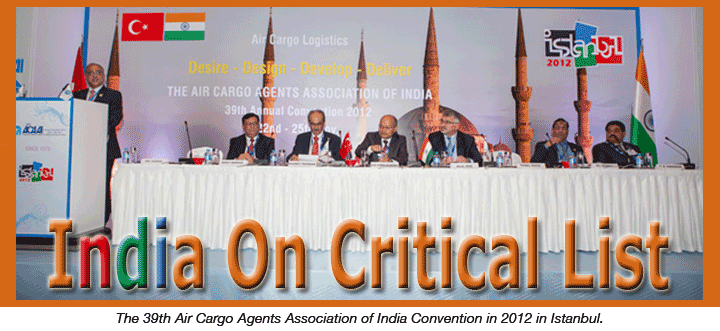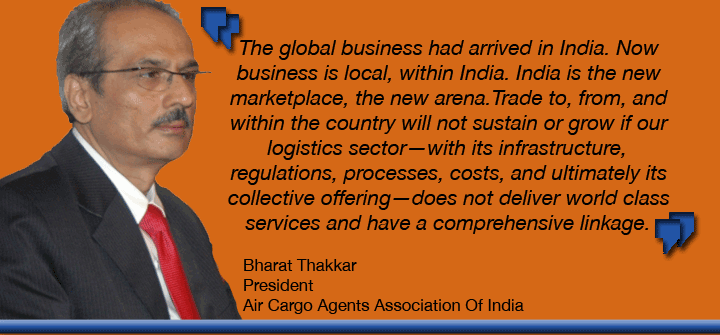
As India goes through a downturn—perhaps,
the worst in 20 years (the economy grew 4.4 percent in the April-June
quarter, the slowest quarterly rate since January-March 2009)—the
Air Cargo Agents Association of India (ACAAI) is, however, steadfast in
the belief that there is hope. Bharat Thakkar, the outgoing President
of the association, said that never before has the importance of the air
cargo logistics industry in India been so crucial.
 |
A month from now, the association will be holding
its 40th annual convention on October 24-27, 2013, and the theme this
year is: “Air cargo in aviation industry – A vital link.”
The meet at Jaipur will look at the changing trends of the logistics environment
and examine market needs and find out how air cargo can be utilized as
a vital link for economic prosperity. Indeed, the timing of the convention
could not have been more appropriate. After the world economic downturn
in 2008, India had a 9 percent GDP growth for two years. But,
of late, the situation has gotten out of hand: along with the tumbling
rupee, commodity prices have been rising, there are virtually no investments,
and the government is burdened by a huge balance of payments.
Speaking to FlyingTypers
about air cargo in the country, Thakkar said: “There are many compelling
factors that have assisted India’s growth at an average of 5 percent
annually. There has been tremendous growth in consumer demand from our
300 million-strong middle-income population, greatly liberalized economic
environment, perhaps the largest educated, English-speaking, and tech-savvy
talent pool, and our youth power.”
He went on to point out that global business
had arrived in India. “It is now local, within India. India is the
new marketplace, the new arena.” However, he also cautioned: “Trade
to, from, and within the country will not sustain or grow if our logistics
sector—with its infrastructure, regulations, processes, costs, and
ultimately its collective offering—does not deliver world class
services and have a comprehensive linkage.”
ACAAI has been working closely with India’s
Ministry of Civil Aviation as a part of the Working Group on Air Logistics.
The report that the Working Group presented had recommendations and timelines
for boosting air cargo. As Thakkar put it: “ACAAI was an integral
part of the Working Group that conceived, created, and presented the report
to the Ministry of Civil Aviation, which will be the foundation on which
the future of air cargo in the country will be built.” The report,
he said, was a vision statement for short-, mid-, and long-term requirements
to catapult the Indian air cargo industry to a challenging position in
the international market.
He mentioned that if the air cargo sector
wanted to be at par with the world, benchmarking was essential but “in
today’s condition (in the country) there is no benchmarking of activities
of any stakeholder and any omission and commission has to be borne by
the importer or the exporter”. He said, “Failure to perform
by the stakeholder—Custodians and carriers—should attract
penal charges.”
A number of Indian airports have seen growth
and modernization, and Hyderabad and Delhi, for example, have been planning
to become cargo hubs or cargo gateways. For its part, the Indian government
has chalked out plans to invest $12 billion in Indian airports under the
12th Five-Year Plan, of which around $9 billion will be from the private
sector. To top it all, the announcement of Foreign Direct Investment in
the aviation sector could bring in foreign carriers interested in boosting
the air cargo sector. Even so, Thakkar listed out the most important items
the air cargo sector would like to see changes in on the national level.
Topping the list was technological connectivity.
“All major airports should have all
related agencies under the terminal roof, with electronic connectivity
to all nodal agencies. What is happening is that slowly such facilities
are being shifted out from the air terminals, leading to additional transaction
costs and time.” He gave an example: the Wildlife Office at Mumbai
Airport had been shifted out.
The second on Thakkar’s wishlist was:
“Filing of IGM (Import General Manifest) at wheels-up stage of origin.
Many of the developed countries mandate filing of IGM at the wheels-up
stage of the flight at the origin both for security and for trade facilitation.”
This procedure, unfortunately, was not followed in India. “In
an electronic mode of transaction of business, filing of IGM at wheels-up
stage is easily possible and should be made mandatory,” he advised.
“ACCAI,” said Thakkar, “has
always been vocal that there should be 24x7 facilities available to trade
and industry for international cargo operations. Supported by the Ministries
of Civil Aviation and Commerce and accepted by the Ministry of Finance,
this dream of ACAAI and industry is now a reality. Though limited to select
locations and confined to select categories, it is bound to expand and
the usage should enlarge in due course,” he said.
Lastly, the ACAAI chief spoke about urgently
enhancing skills of the workforce in air cargo. “While our physical
infrastructure, regulations, operational processes, information systems
and financial resources may be mapped, planned, and provided for, our
intellectual capital and human resources remain the most enigmatic. The
explosive growth in the logistics sector has created a severe dearth of
experienced talent, resulting in greater attrition and its consequent
impact on business continuity. The problems of gaining, training, and
retaining our talent are now acute.”
Tirthankar Ghosh |





